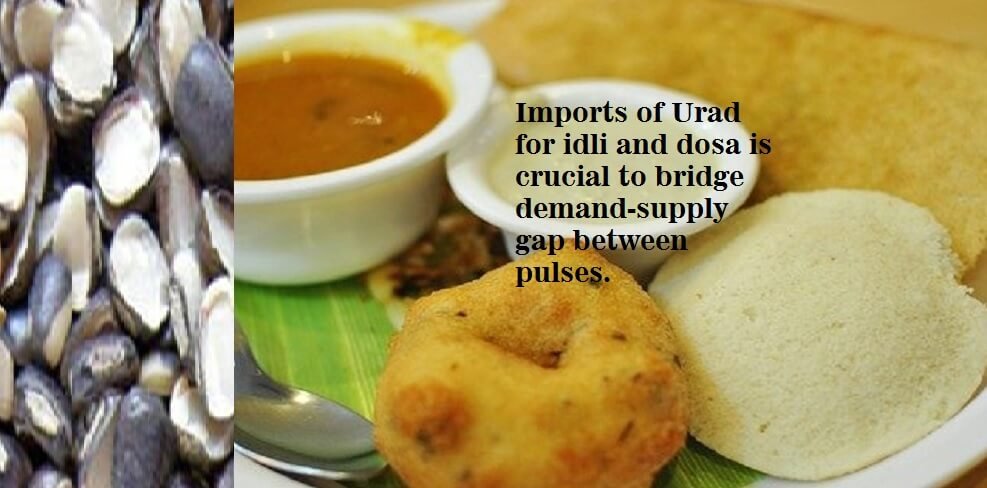Imports of Urad, from Myanmar (formerly Burma), used in food items such as idli, dosa and pappad, are crucial to bridge the demand-supply gap between pulses in the country. This could make things more expensive for food items that are regular in the country, particularly in southern India.
Last week, the Center allowed imports of 4 lakh tonnes of Urad for 2021-22 to bridge supply shortages, as domestic production during the Kharif season was affected by irregular and unseasonal rains.
According to the second advance estimate by the Ministry of Agriculture and Farmers’ Welfare, urad production is estimated at 2,45 million tonnes, which is higher than the final estimate of 2,08 million tonnes.
“The import quota was on the lines expected. However, the shipments will not be smooth due to the prevailing political unrest in Myanmar. We’ll definitely see some hiccups in imports this year,” said Bimal Kothari, Deputy Chairman of the Indian Pulses and Grains Association (IPGA), the apex trading body.
Also Read: India world’s largest producer of pulses adds nearly 24% to global production
The pulse supply chain in Myanmar, the second-largest producer of pulse after India, had already been disrupted by political turmoil.
‘In Myanmar, the crop does not come onto the market due to current disturbances. In addition, shipping companies will not call countries facing unrest in their ships. It’s not going to be a cakewalk to import this year,’ said Kothari, who imports pulses.
Vivek Agarwal of JLV Agro, a commodity brokerage and an efficient procurement firm, said that shipments from Myanmar have already been affected by unrest and about 50,000 tonnes of cargo from the previous year’s quota are stuck in various locations in that country. ‘Cargoes are stuck because the ships are unable to move due to the prevailing situation in the country,’ Agarwal told.
On Saturday, the Maersk shipping line announced a temporary suspension of operational activities in Myanmar from 8 to 14 March. A few days ago, a German container line suspected import bookings to Myanmar, while a French CMA CGM container line had suspended cargo payments in Myanmar.
Also Read: Rabi sowing of cereals, pulses and oilseeds increased 4.7% to 539 lha
In addition to the current political situation, the decline in supplies in Myanmar would also have an effect on Indian urad imports, stated Rahul Chauhan, Managing Director of IGrain India.
‘Three years ago, the restrictions was imposed by the Government on imports of Urad dal hit hard the Myanmar farmers, who then faced difficulties in selling their crops.
However, with the rise in Chinese demand for moong (mung) pick-up, there has been some shift in crop choice among Myanmar farmers. Some of the Urad and tur farmers have moved to Moong. Mr Chauhan has mentioned that the Moong production has almost doubled from 3 lakh tonnes to almost 6 lakh tonnes in Myanmar this year.”
The prices of Urad have been ruling higher than the MSP level of Rs 6,000 for some time now. Chauhan said that urad prices are expected to stay firm and move up until the next crop hits the supply tightening markets around September. Trade also expects prices to govern the firm, depending on how the situation in Myanmar develops in the days ahead.
Domestic urad prices in the Andhra Pradesh markets, where some arrivals are currently taking place, are at Rs 7,600 per quintal, while imported urad is at Rs 7,300-7,400 for fair average quality (FAQ) in Chennai and Mumbai, Agarwal said. In Chennai, prices are around Rs 7,900 for special quality urad.
Market prices of urad dal hover around Rs 127-128 per kg across multiple consumer markets, like Mumbai and Chennai markets, as per the retail prices monitored by the Department of Consumer Affairs.
According to data from the Ministry of Agriculture, urad’s modal prices ranged from Rs 4,899-6,969 per quintal on Friday in various markets of the district of Villupuram in Tamil Nadu.
Urad consumption in India is estimated to be between 2.2-3 million tonnes, according to trade estimates. After chana and tur, urad is the third-largest pulse variety in the country. ‘In general, pulse consumption has risen due to covid-19,’ Mr. Chauhan told. Urad consumption is higher in the southern part of the country, where urad dal is used as idly and as a regular dosage.
Also Read: Cereals are harvested grasses and while pulses are leguminous
Urad production, which reached a record of 3.49 million tonnes in 2017-18, has declined over the last two years due to erratic weather in countries such as Madhya Pradesh and Maharashtra, among others. ‘In addition to the problem of production, the quality of products harvested is also has been poor,’ Mr. Chauhan Mentioned.
India permitted 4 lakh tonnes of urad to be imported during 2020-21, of which almost 3.78 lakh tonnes were imported into the country until January, Chauhan said adding that there were no shipments in February-March. India imported 3.21 lakh tonnes in 2019-20.


















Add Comment